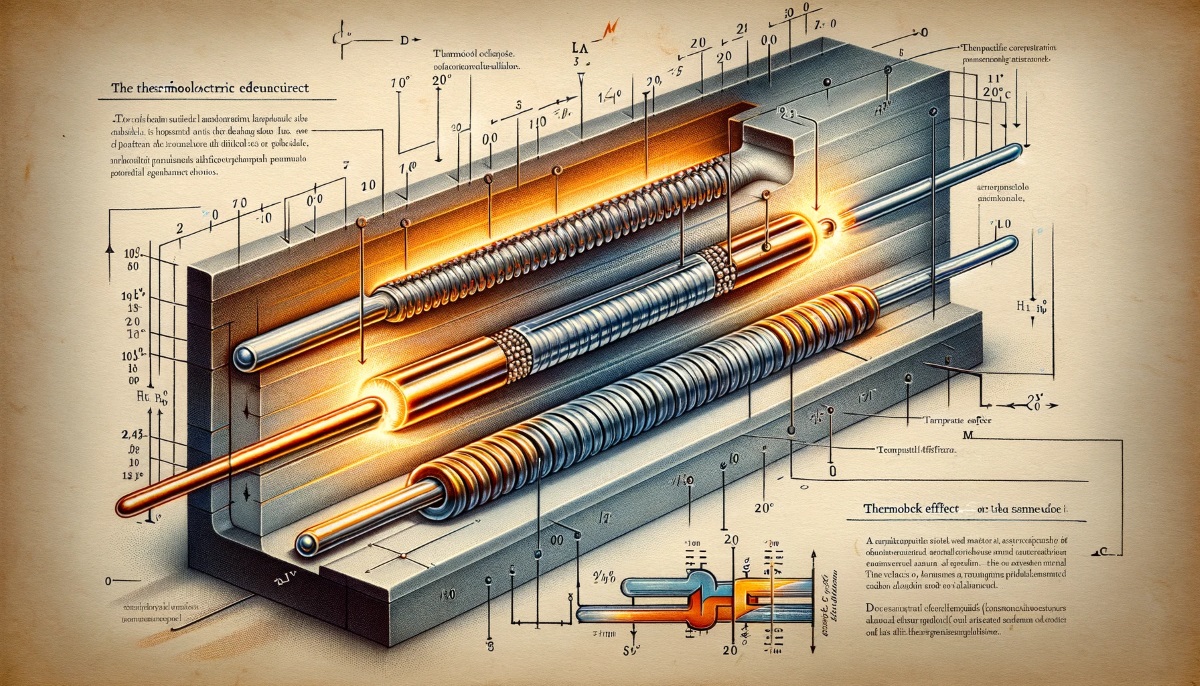What is Seebeck Effect?

What is Seebeck Effect?
The Seebeck Effect is a phenomenon in which a temperature difference between two dissimilar electrical conductors or semiconductors produces an electromotive force (EMF), or voltage. This effect occurs because the temperature difference causes a flow of charge carriers, such as electrons or holes, from one material to the other, creating a potential difference. The magnitude and direction of the voltage produced depend on the types of materials used and the temperature difference between them. The Seebeck Effect is the underlying principle behind thermocouples, which are commonly used to measure temperature in a wide range of applications.
What is Thomson effect?
The Thomson effect is a thermoelectric phenomenon related to the Seebeck effect. It describes the heating or cooling of a conductor when a current flows through it, due to the temperature gradient that is created in the conductor. The Thomson effect is named after William Thomson, also known as Lord Kelvin, who discovered the phenomenon in 1851.
When a current flows through a conductor that has a temperature gradient along its length, the Thomson effect causes the conductor to heat up or cool down, depending on the direction of the current and the direction of the temperature gradient. If the current flows from the colder end of the conductor to the hotter end, the conductor will heat up. If the current flows from the hotter end of the conductor to the colder end, the conductor will cool down. The magnitude of the effect is proportional to the current, the temperature gradient, and the Thomson coefficient, which is a material-specific constant.
The Thomson effect is an important consideration in the design and operation of thermoelectric devices, such as power generators, coolers, and sensors. It can be either beneficial or detrimental, depending on the application. In some cases, the Thomson effect can be minimized or eliminated by selecting materials with low Thomson coefficients or by optimizing the device geometry.
What is Peltier effect?
The Peltier effect is the phenomenon where heat is either absorbed or released at the junction of two different conductive materials when an electric current flows through them. When the electric current flows from one material to another, it can cause one of the materials to absorb heat, while the other material releases heat. The direction of heat flow depends on the direction of the electric current.
In other words, the Peltier effect is a thermoelectric phenomenon in which an electrical current is used to transfer heat from one material to another at the junction between them. This effect is used in many applications, such as in refrigeration and cooling devices, temperature controllers, and thermoelectric power generation.
What is Thermoelectric effect?
The thermoelectric effect is a phenomenon where a temperature difference between two different materials in contact can produce an electric voltage or current. This effect occurs due to the conversion of heat energy into electrical energy or vice versa, depending on the direction of the temperature gradient. The thermoelectric effect is based on the Seebeck effect and the Peltier effect, which are two types of thermoelectric phenomena. The thermoelectric effect is used in various applications, such as thermoelectric generators, thermoelectric cooling systems, and thermocouples.
Seebeck effect vs Peltier effect
The Seebeck effect and Peltier effect are two closely related phenomena in thermoelectricity. The Seebeck effect involves the conversion of a temperature difference into an electric voltage difference, while the Peltier effect involves the generation or absorption of heat when an electric current flows through a junction of two different conductors.
In the Seebeck effect, a voltage is generated across a conductor or semiconductor when there is a temperature gradient across it. This is due to the flow of charge carriers, such as electrons or holes, in response to the temperature difference. The magnitude and polarity of the voltage is proportional to the temperature difference, and is characterized by the material's Seebeck coefficient.
In the Peltier effect, an electric current is passed through a junction of two different conductors, resulting in the transfer of heat between the junction and the surrounding environment. If the current flows in one direction, heat is absorbed at the junction, while in the opposite direction, heat is released at the junction. The amount of heat absorbed or released is proportional to the current, and is characterized by the material's Peltier coefficient.
Both effects are related to the transport of charge carriers and energy in response to temperature gradients and are used in various applications, such as thermoelectric generators, cooling systems, and temperature sensors.
Your shopping cart is empty!
